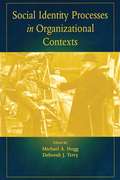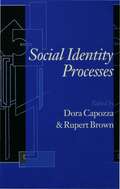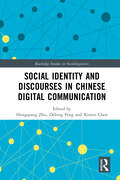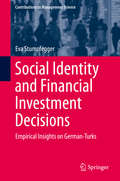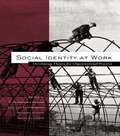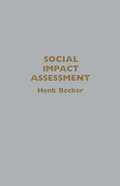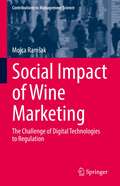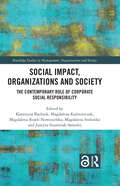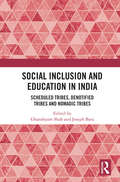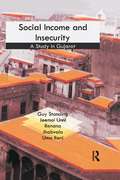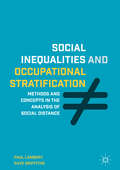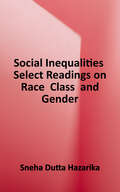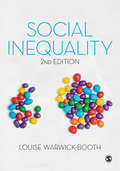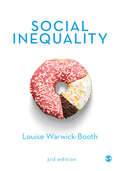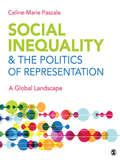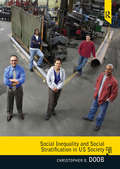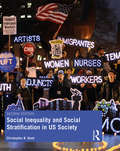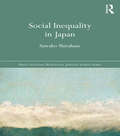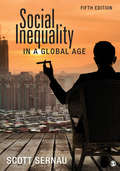- Table View
- List View
Social Identity Processes in Organizational Contexts
by Michael A. Hogg Deborah J. TerryThis new volume is the first to bring together social and organizational psychologists to explore social identity theory in organizational contexts. The chapters are wide ranging - they deal with basic social identity theory, organizational diversity, leadership, employee turnover, mergers and acquisitions, organizational identification, cooperation and trust in organizations, commitment and work, and socialization and influence within organizations. This book is an integrative platform for a closer relationship between social psychologists and organizational psychologists who study social identity processes in organizations.
Social Identity Processes: Trends in Theory and Research
by Dora Capozza Professor Rupert BrownThis landmark work offers a tour of the latest developments in Social Identity Theory from the leading scholars in the field. First proposed by Tajfel and Turner in 1979, Social Identity Theory has proved enormously influential in stimulating new theory and research, and in its application to social problems. The field is developing apace and important new lines of work have opened up in the past few years. The three sections of the book cover: theoretical contributions to the field; recent empirical assessments of key elements of the theory; and applications of Social Identity Theory to bring about changes in problematic intergroup relationships.
Social Identity and Discourses in Chinese Digital Communication (Routledge Studies in Sociolinguistics)
by Xinren Chen Hongqiang Zhu Debing FengExamining how diverse social identities are constructed in digital communication in China, this edited collection provides a multidimensional exploration of the diverse, discursive forms and practices used to construct and present the “self” online. Contributing authors provide analyses of China’s digital communication platforms, such as social media platforms, news websites and short video applications, drawing from a wealth of data to study daily practices of digital performance of identity and maintenance of social bonds.Comprised of nine chapters, this essential volume is divided into three distinct sections, taking a hierarchical approach to analysing social identities within Chinese digital communication at the micro, meso and macro levels. Diverse methodologies are applied throughout, incorporating insights from both linguistic theories and semiotic or textually oriented analyses, while also considering the wider societal contexts.Readers are encouraged to analyse the main features of this digital culture and to investigate how language and discourse are encountered through media. This book will be of value to a wide variety of scholars and students in sociolinguistics, communication studies and Asian studies.
Social Identity and Financial Investment Decisions
by Eva StumpfeggerThis book investigates how social identity relates to financial investment behavior of the German-Turkish diaspora. The author approaches this study using qualitative research and multiple semi-structured in-depth interviews with a strong philosophical and methodological basis. Taking a phenomenological stance, the empirical results reveal many nuanced shades of bi-cultural identity. Key findings include a range of social creativity behaviors, also offering an extension to social identity theory by means of re-defining relevant in-groups. Financial investments are considered a family affair, with children being heavily involved and support of (extended) family is defined as investment. Within that realm, German social identity prevails with regard to financial investments.
Social Identity at Work: Developing Theory for Organizational Practice
by Daan Van Knippenberg S. Alexander Haslam Michael J. Platow Naomi EllemersSocial identity research is very much on the ascendancy, particularly in the field of organizational psychology. Reflecting this fact, this volume contains chapters from researchers at the cutting edge of these developments.
Social Imaginary and the Metaphysical Discourse: On the Fundamental Predicament of Contemporary Philosophy and Social Sciences (Routledge Studies in Social and Political Thought)
by Christoforos BouzanisThis book departs from approaches to truth in social science and ideas in philosophy that connect truth to the ability of language to fulfil certain ‘real-world’ conditions of objectivity. Pointing to an extra-linguistic level in our cognition at which scientific creativity occurs, it highlights the manner in which epistemic communities share, work on and modify not only the world-imaginaries that they endorse, but also those world-views that they reject or which partially overlap with their own. Through the concept of the social imaginary, the author explores the theoretical interrelations among various metaphysical world-imageries by which we organise our scientific understanding of the world and our expectations of experience, thus shedding light on the manner in which social ontology can inform our practices of sharing belief. A study at the intersection of metaphysics and social theory, The Fundamental Predicament of Contemporary Philosophy and the Social Sciences will appeal to scholars of sociology and philosophy with interests in questions of ontology and epistemology.
Social Impact Assessment: Method And Experience In Europe, North America And The Developing World (Elgar Original Reference Ser.)
by Becker, Henk Henk Becker University of Utrecht, Netherlands.This book is intended for introductory courses in SIA within sociology, social policy, human geography and political science at postgraduate level. Specialist postgraduate and professional courses in policy- orientated social research and in social and general impact assessment.
Social Impact of Wine Marketing: The Challenge of Digital Technologies to Regulation (Contributions to Management Science)
by Mojca RamšakThis book is inspired by the term “digiwine,” a neologism referring to the production and/or marketing of wine through the use of new technologies and robotics such as vineyard information systems, sensor units, weather stations, drones, robotic harvesters, social media videos, digital labels, and wine apps. The alcohol industry is using these technologies to develop digital strategies and online tools for more efficient sales of wine. This book analyzes the use of digital alcohol marketing, the reasons for it, the role of regulation, and its social impact. In particular, malignant forms of alcohol marketing to youth are precisely described through exact case descriptions from the global milieu. The author questions whether the loopholes in the legislation or inefficiency of self-regulation have negative consequences that can no longer be prevented by public health care programs. When and how did the alcohol industry become so deeply interwoven in our lives that we mindlessly advertise and parade in its shadow on social media and that we increasingly buy alcohol digitally for fun, in innovative packaging, and with strange ingredients combinations? Dr. Mojca Ramšak’s book peels back the layers of the alcohol industry’s most obvious yet overlooked marketing tactics. It also reveals the sluggishness of preventive and curative efforts, as well as legal or self-regulatory measures, at keeping up with the alcohol industry’s use of technology. - Nadja Furlan Štante, Principal Research Associate and Professor of Religious Studies, Science and Research Centre of Koper, Slovenia.
Social Impact, Organizations and Society: The Contemporary Role of Corporate Social Responsibility (Routledge Studies in Management, Organizations and Society)
by Magdalena Stefańska Katarzyna Bachnik Magdalena Kaźmierczak Magdalena Rojek-Nowosielska Justyna Szumniak-SamolejSocial Impact, Organizations and Society represents endeavors to comprehensively explore the essence of social impact. The editors aim to elucidate its definition, scope, measurement and implementation. Delving into how organizations integrate social impact into their core missions, decision-making processes and operational frameworks, this monograph strives to identify avenues for enhancing social impact generation. Furthermore, its focus lies on fostering effective relationships with diverse stakeholder groups and providing empirical evidence of social impact practices across industries and sectors. Through an in-depth examination of the latest research, this monograph sheds light on the evolving role of corporate social responsibility and its significance amidst contemporary challenges.Chapters 1, 3, 4, 5, 6, 11 and 14 of this book are freely available as a downloadable Open Access PDF at http://www.taylorfrancis.com under a Creative Commons Attribution-Non Commercial-No Derivatives (CC-BY-NC-ND) 4.0 license.
Social Inclusion and Education in India: Scheduled Tribes, Denotified Tribes and Nomadic Tribes
by Ghanshyam Shah Joseph BaraThis book examines social inclusion in the education sector in India for scheduled tribes (ST), denotified tribes and nomadic tribes. It investigates the gaps between what was promised to the marginalized sections in the constitution, and what has since been delivered. The volume:• Examines data from across the Indian states on ST and non-ST students in higher, primary and secondary education;• Analyses the success and failures of education policy at the central and state level;• Brings to the fore colonial roots of social exclusion in education. A major study, the volume will be of great interest to scholars and researchers of education, sociology and social anthropology, development studies and South Asian studies.
Social Income and Insecurity: A Study in Gujarat
by Guy Standing Renana Jhabvala Jeemol Unni Uma RaniEconomic liberalisation associated with globalisation is causing a pervasive growth of economic insecurity experienced all over the world. This is placing urgent demands on policymakers to rethink old policies and institutions. This book sets out a new approach to the assessment of income dynamics, based on identifying the diverse components of people’s income and entitlements. It defines ‘social income’ as a broader concept of household income which includes state, community and private benefits. It shows how those components should be measured and provides a composite picture of the structure of incomes and support systems of different societal groups. It recognises how the structure of income, as well as its distribution, has been linked to policy and development dynamics. It starts from a premise that unless the totality of incomes and income support systems is taken into account, academics and policymakers cannot expect to develop appropriate interventions. This perspective is developed though a detailed household survey conducted in rural and urban areas of Gujarat in 2007–2008. This provides an up-to-date picture of how institutions, NGOs and the state system are operating in the context of rapid restructuring of village life in India.
Social Inequalities (New Approaches to Sociology)
by Anya Ahmed Deirdre Duffy Lorna ChestertonPart of the New Approaches to Sociology series, Social Inequalities is a relevant and valuable exploration of how we see the world, through a decolonised lens. Aimed at undergraduate and postgraduate students of sociology, this textbook offers a critical re-reading of traditional approaches to understanding social inequalities and responds to the call from university administrations, academics and students to decolonise the curriculum and challenge its lack of diversity. It presents an intersectional approach to understanding diversity and social inequalities and, in so doing, allows for alternative knowledge sources and voices to be heard. From looking at social groups such as race, age, sexuality and class alongside a nuanced evaluation of traditional sociological theories such as Marxism, functionalism and feminism – this book is an expert guide to the debates central to understanding the challenges individuals face in society. Including personal stories and case studies, students will be exposed to an authentic and real-world view of how individuals have encountered discrimination. Social Inequalities is an essential resource for anyone working and studying across sociology, and anyone interested in challenging established ways of looking at the world. Professor Anya Ahmed, Dr Deirdre Duffy and Dr Lorna Chesterton work in the faculty of health and education at Manchester Metropolitan University, UK.
Social Inequalities (New Approaches to Sociology)
by Anya Ahmed Deirdre Duffy Lorna ChestertonPart of the New Approaches to Sociology series, Social Inequalities is a relevant and valuable exploration of how we see the world, through a decolonised lens. Aimed at undergraduate and postgraduate students of sociology, this textbook offers a critical re-reading of traditional approaches to understanding social inequalities and responds to the call from university administrations, academics and students to decolonise the curriculum and challenge its lack of diversity. It presents an intersectional approach to understanding diversity and social inequalities and, in so doing, allows for alternative knowledge sources and voices to be heard. From looking at social groups such as race, age, sexuality and class alongside a nuanced evaluation of traditional sociological theories such as Marxism, functionalism and feminism – this book is an expert guide to the debates central to understanding the challenges individuals face in society. Including personal stories and case studies, students will be exposed to an authentic and real-world view of how individuals have encountered discrimination. Social Inequalities is an essential resource for anyone working and studying across sociology, and anyone interested in challenging established ways of looking at the world. Professor Anya Ahmed, Dr Deirdre Duffy and Dr Lorna Chesterton work in the faculty of health and education at Manchester Metropolitan University, UK.
Social Inequalities and Occupational Stratification: Methods And Concepts In The Analysis Of Social Distance
by Paul Lambert Dave GriffithsThis book explores how structures of social inequality are linked to the social connections that people hold. The authors focus upon occupational inequalities where they see, for example, that the typical friendship patterns of people from one occupation are often very different to those of people from another. Social Inequalities and Occupational Stratification leverages empirical data about differences in social connections to chart structures of social distance and social inequality. Several of its chapters provide coverage of the long-standing Cambridge Social Interaction and Stratification scale (CAMSIS) project and its approach to analysing social interaction patterns in terms of a single dimension related to social inequality.
Social Inequalities: Select Readings on Race, Class, and Gender
by Sneha Dutta HazarikaFeaturing an intersectional approach, this text introduces students to social inequalities embedded within society at both the micro and macro level. Through compelling, scholarly articles, students gain the knowledge necessary to address social inequalities and inspire social change. The anthology features six distinct units. <p><p>Unit I focuses on race, racism, and immigration and features readings on racial formation, defining racism, and the consequences of racism on U.S. immigration policy. In Unit II, students read about gender, patriarchy, and formal and informal discrimination against women at work. Unit III features coverage of social class, power, and privilege, and Unit IV speaks to the tensions between wealth, privilege, and inequality. Students learn about inequality and discrimination within social institutions like schools, housing, and mass incarceration. The final unit encourages students to pursue social change and social transformation. <p><p>This book is an ideal reader for courses in sociology, women and gender studies, and race and ethnic studies, as well as those that address social stratification and the intersectionality of race, ethnicity, class, and gender.
Social Inequality
by Dr Louise Warwick-BoothNow in an updated second edition, Social Inequality continues to be an essential guide to understanding social inequality and stratification, helping readers to understand what inequality is, how it is defined, explored and measured, and what the key social divisions are at both global and national level. The new edition includes updated coverage of sexuality and transgender issues, enhanced discussion of migration and asylum seeking, and further coverage of a global context for social inequalities, policy, and justice. The book also features two new chapters: Youth and Age, which discusses age as a social construct and form of division, the implications of ageing populations, ageism as a form of discrimination, and the different cultural understandings of age. Health and Disability, which defines health inequalities, outlines a range of global and national examples, and analyses the current thinkers on health inequalities and their proposed solutions. Suitable course reading for students on modules examining social justice, social policy, social class, and social inequalities.
Social Inequality
by Dr Louise Warwick-BoothNow in an updated second edition, Social Inequality continues to be an essential guide to understanding social inequality and stratification, helping readers to understand what inequality is, how it is defined, explored and measured, and what the key social divisions are at both global and national level. The new edition includes updated coverage of sexuality and transgender issues, enhanced discussion of migration and asylum seeking, and further coverage of a global context for social inequalities, policy, and justice. The book also features two new chapters: Youth and Age, which discusses age as a social construct and form of division, the implications of ageing populations, ageism as a form of discrimination, and the different cultural understandings of age. Health and Disability, which defines health inequalities, outlines a range of global and national examples, and analyses the current thinkers on health inequalities and their proposed solutions. Suitable course reading for students on modules examining social justice, social policy, social class, and social inequalities.
Social Inequality
by Louise Warwick-BoothThis book provides up to date discussion and evidence about inequalities, social divisions and stratification. Its innovative style engages readers and encourages them to reflect upon the many dimensions of social inequality. This updated third edition contains: Three new chapters on employment, sexualities and migration Updated coverage of intersectionality throughout Thirteen new in-depth case studies (one per chapter) This is a must read as a key introductory companion for students who wish to understand the dynamics of contemporary social inequality. Louise Warwick-Booth is a Reader at the School of Health, Leeds Beckett University
Social Inequality
by Louise Warwick-BoothThis book provides up to date discussion and evidence about inequalities, social divisions and stratification. Its innovative style engages readers and encourages them to reflect upon the many dimensions of social inequality. This updated third edition contains: Three new chapters on employment, sexualities and migration Updated coverage of intersectionality throughout Thirteen new in-depth case studies (one per chapter) This is a must read as a key introductory companion for students who wish to understand the dynamics of contemporary social inequality. Louise Warwick-Booth is a Reader at the School of Health, Leeds Beckett University
Social Inequality & The Politics of Representation: A Global Landscape
by Celine-Marie PascaleIn a global landscape, the representational practices through which inequalities gain meaning are central- both within and across national boundaries. Social Inequality & The Politics of Representation takes a fresh look at how inequalities of class, race, sexuality, gender, and nation are constructed in twenty countries on five continents. It offers both rich insight and cultural critique- yet it does not offer a universal paradigm, nor is it concerned with debates about scholarship from "the center" or "the periphery". The collection de-centers North American/European paradigms by placing scholarship from countries around the globe on equal footing. Readers will find a variety of analytical styles including frame analysis, semiotics, poststructural discourse analysis, critical discourse studies, and conversation analysis. Each chapter provides an overview of relevant cultural and historical contexts for an international audience as well as a brief introduction to relevant methodological and theoretical frameworks. Consequently, it is both a richly diverse and easily accessible collection.
Social Inequality and Social Stratification in U.S. Society
by Christopher B. DoobSocial Inequality - examining our present while understanding our past. Social Inequality and Social Statification in US Society, 1st edition uses a historical and conceptual framework to explain social stratification and social inequality. The historical scope gives context to each issue discussed and allows the reader to understand how each topic has evolved over the course of American history. The authors use qualitative data to help explain socioeconomic issues and connect related topics. Each chapter examines major concepts, so readers can see how an individual's success in stratified settings often relies heavily on their access to valued resources-types of capital which involve finances, schooling, social networking, and cultural competence. Analyzing the impact of capital types throughout the text helps map out the prospects for individuals, families, and also classes to maintain or alter their position in social-stratification systems. Learning Goals Upon completing this book, readers will be able to: Analyze the four major American classes, as well as how race and gender are linked to inequalities in the United States Understand attempts to reduce social inequality Identify major historical events that have influenced current trends Understand how qualitative sources help reveal the inner workings that accompany people's struggles with the socioeconomic order Recognize the impact of social-stratification systems on individuals and families
Social Inequality and Social Stratification in US Society
by Christopher B. DoobSocial Inequality and Social Stratification in US Society uses a historical and conceptual framework to explain social stratification and social inequality. The historical scope gives context to each issue discussed and allows the reader to understand how each topic has evolved over the course of American history. The author uses qualitative data to help explain socioeconomic issues and connect related topics. Each chapter examines major concepts, so readers can see how an individual’s success in stratified settings often relies heavily on their access to valued resources—types of capital which involve finances, schooling, social networking, and cultural competence. Analyzing the impact of capital types throughout the text helps map out the prospects for individuals, families, and also classes to maintain or alter their position in social-stratification systems.
Social Inequality in Japan: Social Inequality In Japan (Nissan Institute/Routledge Japanese Studies)
by Sawako ShirahaseJapan was the first Asian country to become a mature industrial society, and throughout the 1970s and the 1980s, was viewed as an ‘all-middle-class society’. However since the 1990s there have been growing doubts as to the real degree of social equality in Japan, particularly in the context of dramatic demographic shifts as the population ages whilst fertility levels continue to fall. This book compares Japan with America, Britain, Italy, France, Germany, Sweden and Taiwan in order to determine whether inequality really is a social problem in Japan. With a focus on impact demographic shifts, Sawako Shirahase examines female labour market participation, income inequality among households with children, the state of the family, generational change, single person households and income distribution among the aged, and asks whether increasing inequality and is uniquely Japanese, or if it is a social problem common across all of the societies included in this study. Crucially, this book shows that Japan is distinctive not in terms of the degree of inequality in the society, but rather, in how acutely inequality is perceived. Further, the data shows that Japan differs from the other countries examined in terms of the gender gap in both the labour market and the family, and in inequality among single-person households – single men and women, including lifelong bachelors and spinsters – and also among single parent households, who pay a heavy price for having deviated from the expected pattern of life in Japan. Drawing on extensive empirical data, this book will be of great interest to students and scholars interested in Japanese culture and society, Japanese studies and social policy more generally.
Social Inequality in a Global Age
by Scott R. SernauThis updated Fifth Edition of Scott Sernau's acclaimed text provides a sociological framework for analyzing inequality within the United States in the context of global stratification and a rapidly changing world economy. With insightful analysis, the text provides an accessible introduction to stratification systems and the structural and personal realities of growing class divides. Using examples drawn straight from today's headlines, Sernau explores each dimension of inequality as he analyzes the relationship between changing global power and growing inequalities within countries. Throughout, a focus on social action and community engagement encourages students to become involved, active learners in the classroom and engaged citizens in their communities.
Social Inequality in a Global Age
by Scott R. SernauThis updated Fifth Edition of Scott Sernau's acclaimed text provides a sociological framework for analyzing inequality within the United States in the context of global stratification and a rapidly changing world economy. With insightful analysis, the text provides an accessible introduction to stratification systems and the structural and personal realities of growing class divides. Using examples drawn straight from today's headlines, Sernau explores each dimension of inequality as he analyzes the relationship between changing global power and growing inequalities within countries. Throughout, a focus on social action and community engagement encourages students to become involved, active learners in the classroom and engaged citizens in their communities.
